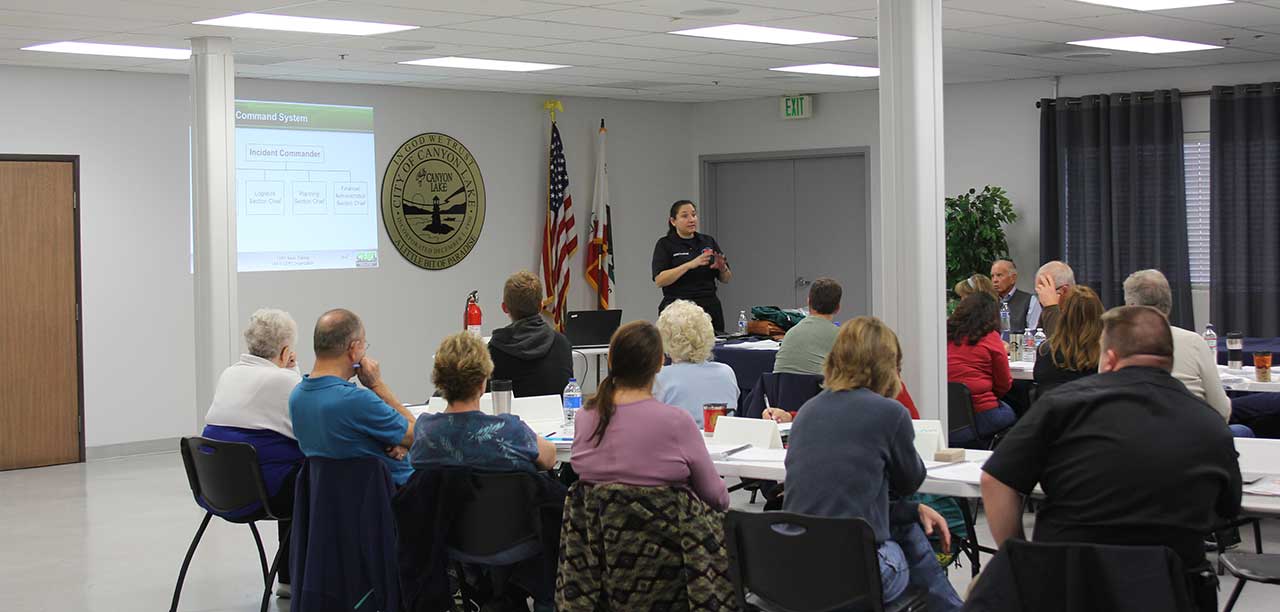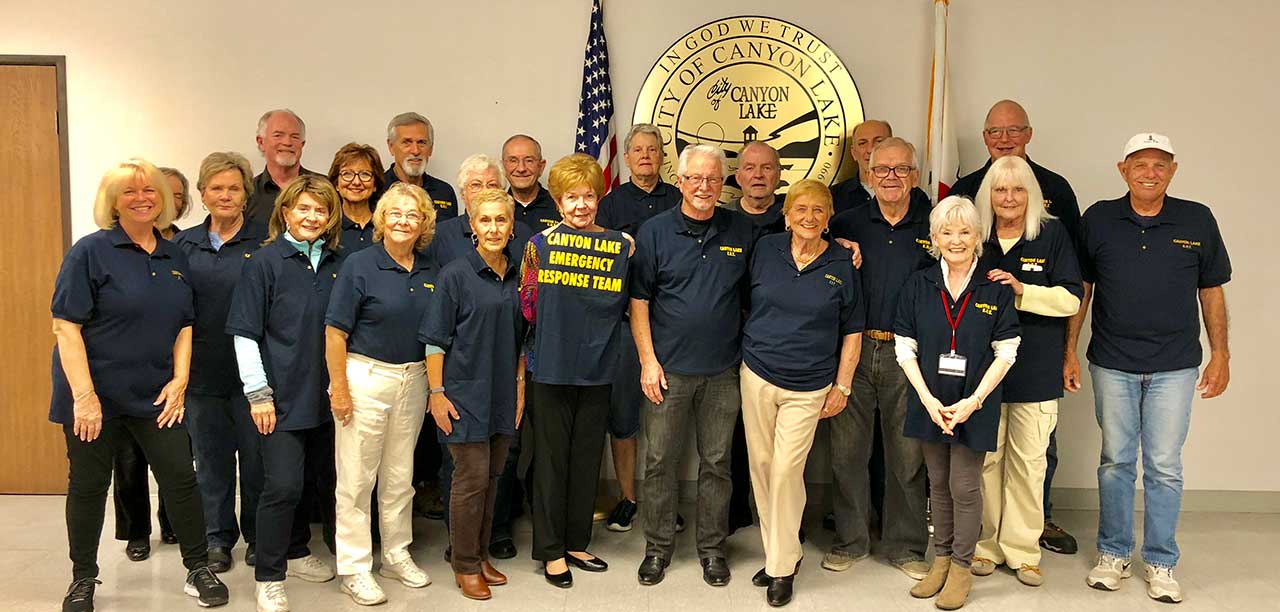Is Canyon Lake prepared in the event of a disaster?
Thursday morning’s 4.0 earthquake centered 9.94 miles WNW of Lake Elsinore should be a reminder to all Canyon Lake residents the importance of having an emergency plan in the event of a disaster. A disaster can strike at anytime. Are you prepared? Do you have a plan for your family? Pets? Do you have an emergency supply of food and water? Don’t wait until a disaster strikes to make a plan. Having a plan before an emergency strikes may save your life and the lives of your family members.
What is the city doing to prepare for a disaster? The City of Canyon Lake has established and sponsors the Canyon Lake Emergency Preparedness Committee (CLEPC) which works in coordination with Riverside County Fire, the Sheriff’s Department and Emergency Services. The committee also has liaisons with the American Red Cross.
The committee is a group of volunteers working together to prepare the city for any disaster. The objective of the committee is to encourage, implement, and support an emergency services response and disaster management system that protects the citizens of Canyon Lake from effects of major emergencies and disasters, while fostering a leadership vision where everyone practices sound emergency management concepts and principles that protect lives, property and environment.
The CLEPC meets on the first Thursday of each month, except during the months of July and August, at 6:30 p.m. in the Council Chamber at city hall. At these meetings, citizens are offer updated information on disaster preparedness, provided educational opportunities to learn how best to cope during a disaster and through a volunteer vetting procedure have the opportunity to become a certified Disaster Health Responder.
We stress to our volunteers that family comes first during a disaster, and being prepared is of key importance. Citizens who wish to attend for information updates are very welcome. Citizens who wish to assume a response role in times of need can volunteer in many areas such as EOC operations, Casualty Collection Point, Damage Assessment or Shelter Operation. The latter category requires a vetting procedure and additional FEMA and Red Cross education classes.
The committee is actively involved in our community, providing a first aid station at community events, and teaching “hands-only” CPR to any club who requests this. Some future plans include the implantation of Drone technology for disaster survey and CERT training for our citizens.
Here is a brief history of Canyon Lake Emergency Preparedness Committee: In 1989, well before Canyon Lake became incorporated, the residents in this rural development gathered to form a group of volunteers who would respond to emergencies in Canyon Lake. Membership was built on asking each of the clubs to send two representatives to attend meetings. These people went door to door asking for donations of shovels, tarps, medical equipment, or any other items which could possibly be needed after a disaster. The first president moved away after about eight months. Frank Webster stepped in as president until his resignation in 1991. Nancy Carroll was appointed to lead the committee and remained president until she stepped down in 2016. I’ve succeeded her as president.
The demographics of Canyon Lake are much different now. Riverside County has established a comprehensive disaster response. The citizens living here are busily involved with work, raising families and commuting. We are no longer “rural.” Having said that, we still remain a tight-knit community with a caring attitude for all who live here. We need volunteers not to disappear.
As the demographics of Canyon Lake have changed so has emergency response. All have
witnessed the recent disasters which have taken lives and destroyed property. We have also seen the heroism of neighbors helping neighbors to survive. Volunteerism is difficult to sustain, preparedness is essential.
The CLEPC wants to grow and expand to help the community to survive. Each citizen has the potential to be a hero, all have the potential to learn how and contribute when the need arises. We encourage residents to come see what the CLEPC is all about. Attend a two-hour meeting and become acquainted with your fellow neighbors who are investing their time and expertise to safeguard the citizens of Canyon Lake. Be aware, be prepared. Proverbs 22:3 says, “A prudent man foresees the difficulties ahead and prepares for them; the simpleton goes blindly on and suffers the consequences.”
General precautions:
The National Safety Council recommends the following general precautions:
- Make sure to have a family communication plan in place; all members of the family should review and practice the plan.
- Have all family members’ and other important phone numbers written down or memorized.
- Be sure to store all important documents – birth certificates, insurance policies, etc. – in a fire-proof safe or safety deposit box.
- Assign one family member the responsibility of learning first aid and CPR
Know how to shut off utilities.
Plans for families:
Fema recommends these four steps for developing a plan for families:
Step 1: Put together a plan by discussing these four questions with your family, friends, or household to start your emergency plan.
- How will I receive emergency alerts and warnings?
- What is my shelter plan?
- What is my evacuation route?
- What is my family/household communication plan?
Step 2: Consider specific needs in your household.
As you prepare your plan, tailor your plans and supplies to your specific daily living needs and responsibilities. Discuss your needs and responsibilities and how people in the network can assist each other with communication, care of children, business, pets, or specific needs like the operation of durable medical equipment. Create your own personal network for specific areas where you need assistance. Keep in mind some these factors when developing your plan:
- Different ages of members within your household
- Responsibilities for assisting others
- Locations frequented
- Dietary needs
- Medical needs including prescriptions and equipment
- Disabilities or access and functional needs including devices and equipment
- Languages spoken
- Cultural and religious considerations
- Pets or service animals
- Households with school-aged children
Step 3: Fill out a Family Emergency Plan
Step 4: Practice your plan with your family/household
Emergency Preparedness for seniors:
Create a support network of family, friends and others who can assist you during an emergency, and share your disaster plans with them. Practice your plan with them. Make sure they have an extra key to your home, know where you keep your emergency supplies and how to use lifesaving equipment or administer medicine.
If you undergo routine treatments administered by a clinic or hospital, find out their emergency plans and work with them to identify back-up service providers.
If you have a communication-related disability, note the best way to communicate with you.
Don’t forget your pets or service animals. Not all shelters accept pets, so plan for alternatives and be sure to prepare an emergency it for your pet.
A disaster can disrupt mail service for days or weeks. If you depend on Social Security or other regular benefits, switching to electronic payments is a simple, significant way to protect yourself financially before disaster strikes. It also eliminates the risk of stolen checks. The U.S. Department of the Treasury recommends two safer ways to get federal benefits:
- Direct deposit to a checking or savings account. Federal benefit recipients can sign up by calling (800) 333-1795 or sign up online.
- The Direct Express prepaid debit card is designed as a safe and easy alternative to paper.
Emergency Preparedness for pets:
Don’t’ forget to make a plan for your pets. Just as you do with your family’s emergency supply kit, think first about the basics for survival, particularly food and water. Consider two kits. In one, put everything you and your pets will need to stay where you are. The other should be a lightweight, smaller version you can take with you if you and your pets have to get away. Be sure to review your kits regularly to ensure that their contents, especially foods and medicines, are fresh.
Buddy system: Plan with neighbors, friends or relatives to make sure that someone is available to care for or evacuate your pets if you are unable to do so. Talk with your pet care buddy about your evacuation plans and show them where you keep your pet’s emergency supply kit. Also designate specific locations, one in your immediate neighborhood and another farther away, where you will meet in an emergency.
Food: Keep at least three days of food in an airtight, waterproof container.
Water; Store at least three days of water specifically for your pets in addition to water you need for yourself and your family.
Medicines and medical records: Keep an extra supply of medicines your pet takes on a regular basis in a waterproof container.
First aid kit: Talk to your veterinarian about what is most appropriate for your pet’s emergency medical needs. Most kits should include cotton bandage rolls, bandage tape and scissors; antibiotic ointment; flea and tick prevention; latex gloves, isopropyl alcohol and saline solution. Include a pet first aid reference book.
Collar with ID tag, harness or leash: Your pet should wear a collar with its rabies tag and identification at all times. Include a backup leash, collar and ID tag in your pet’s emergency supply kit. In addition, place copies of your pet’s registration information, adoption papers, vaccination documents and medical records in a clean plastic bag or waterproof container and also add them to your kit. You should also consider talking with your veterinarian about permanent identification, such as microchipping and enrolling your pet in a recovery database.
Crate/pet carrier: If you need to evacuate in an emergency situation take your pets and animals with you provided that it is practical to do so. In many cases, your ability to do so will be aided by having a sturdy, safe, comfortable crate or carrier ready for transporting your pet. The carrier should be large enough for your pet to stand, turn around and lie down.
Sanitation: Include pet litter and litter box if appropriate, newspapers, paper towels, plastic trash bags and household chlorine bleach to provide for your pet’s sanitation needs. You can use bleach as a disinfectant (dilute nine parts water to one part bleach) or in an emergency you can also use it to purify water. Use 16 drops of regular household liquid bleach per gallon of water. Do not use scented or color safe bleaches, or those with added cleaners.
Editor’s note: Larry Greene is mayor pro tem of Canyon Lake and president of the Canyon Lake Emergency Preparedness Committee. His career background in fire and safety and public safety is extensive.
The 39 year resident of Canyon Lake spent 31 years as a municipal fire professional which included positions as division chief of operations and EMS, fire marshal and assistant fire chief for a large Orange County city. His vision for Canyon Lake is to keep its citizens safe, providing essential services.
Previous Article
2017 Photos of the Year – Part 4



 April 26, 2024
April 26, 2024